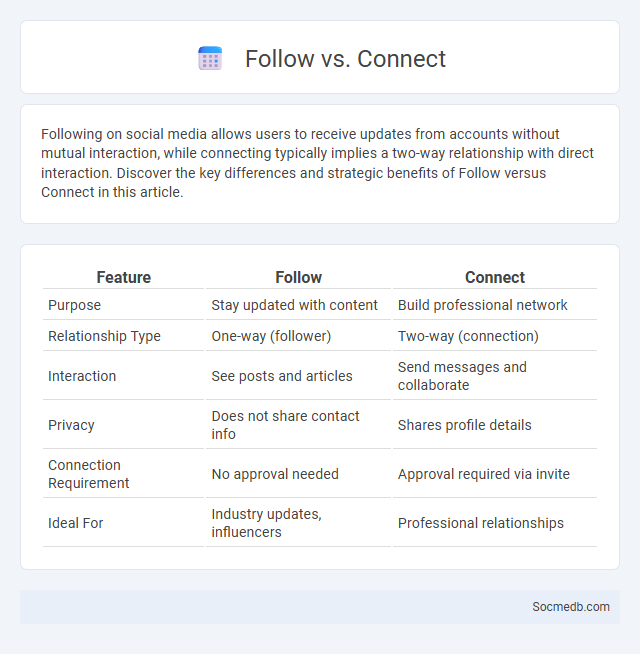
Photo illustration: Follow vs Connect
Following on social media allows users to receive updates from accounts without mutual interaction, while connecting typically implies a two-way relationship with direct interaction. Discover the key differences and strategic benefits of Follow versus Connect in this article.
Table of Comparison
| Feature | Follow | Connect |
|---|---|---|
| Purpose | Stay updated with content | Build professional network |
| Relationship Type | One-way (follower) | Two-way (connection) |
| Interaction | See posts and articles | Send messages and collaborate |
| Privacy | Does not share contact info | Shares profile details |
| Connection Requirement | No approval needed | Approval required via invite |
| Ideal For | Industry updates, influencers | Professional relationships |
Understanding "Follow," "Connect," and "Connection": Key Differences
Follow," "Connect," and "Connection" represent distinct actions on social media platforms with unique implications. "Follow" allows users to receive updates from another user's public content without mutual approval, enhancing content consumption and audience reach. "Connect" typically requires mutual consent, establishing a direct link between users for more personalized interaction, while a "Connection" signifies an established link facilitating private messaging and stronger networking opportunities.
The Purpose Behind Following: Why Do We Follow Others Online?
Understanding the purpose behind following others on social media reveals key motivations such as staying informed, seeking inspiration, or building a community aligned with Your interests. People follow influencers, brands, or friends to access curated content that matches their preferences and values. This behavior enhances engagement and personalized online experiences while shaping social identity and digital relationships.
Connecting with Others: Defining Digital Connections
Digital connections on social media platforms facilitate real-time interaction, enabling users to share experiences, ideas, and emotions across vast distances. These connections are defined by the exchange of multimedia content, messages, and comments that foster virtual communities and personal relationships. Social networks like Facebook, Instagram, and LinkedIn serve as hubs for building and maintaining meaningful digital relationships through consistent engagement and shared interests.
What Does "Connection" Really Mean on Social Platforms?
Connection on social media transcends mere friend counts or follower numbers; it embodies meaningful interactions, authentic engagement, and shared experiences that foster genuine relationships. You build connection by actively participating in conversations, offering support, and creating content that resonates with your audience. True connection reflects trust, emotional resonance, and ongoing dialogue, making social platforms essential tools for community and relationship building.
Follow vs Connect: Which Strategy Builds a Stronger Network?
Choosing to connect rather than merely follow on social media fosters deeper relationships and meaningful interactions that can significantly enhance your professional and personal network. Connections enable two-way communication, increasing trust and engagement, while follows offer a one-sided relationship with limited impact. Your strategic focus on building connections ultimately creates a stronger, more supportive network with valuable opportunities for collaboration and growth.
The Impact of Followers vs Connections on Your Online Presence
Followers on social media significantly amplify your online presence by increasing visibility, engagement, and potential reach, while connections foster deeper, more meaningful interactions and trust within your network. A large follower count can boost perceived authority and brand influence, but cultivating authentic connections enhances long-term credibility and personalized communication. Balancing both followers and connections strategically strengthens your digital reputation and maximizes opportunities for growth.
Connection Requests: Best Practices for Meaningful Engagement
Connection requests on social media should be personalized, highlighting mutual interests or shared groups to increase acceptance rates. Crafting concise messages that clearly state the purpose of connection fosters trust and encourages meaningful engagement. Regularly reviewing and following up on pending requests helps maintain proactive networking and build authentic relationships.
Quality Connections vs Quantity of Followers: Which Matters More?
Quality connections on social media foster genuine engagement, trust, and meaningful interactions that lead to long-term relationships and brand loyalty. Quantity of followers may boost visibility, but without authentic engagement, it often results in superficial metrics that don't translate into real influence or business growth. Focusing on your social media strategy to cultivate quality connections will maximize your impact and create lasting value.
Leveraging "Follow" and "Connect" Features for Personal Branding
Leveraging the "Follow" and "Connect" features on social media platforms can significantly enhance your personal branding by expanding your network and increasing visibility among industry leaders and potential clients. Engaging with relevant professionals through these tools fosters meaningful relationships and positions you as an active, trusted expert in your niche. Consistent interaction and strategic connection requests amplify your online presence, driving opportunities for career growth and brand recognition.
Maximizing Connections: Tips for Building a Powerful Social Network
Maximizing connections on social media involves strategically engaging with diverse communities to expand your network and influence. Prioritize quality interactions by sharing valuable content, responding to comments, and participating in relevant groups or discussions. Leveraging consistent branding and authentic communication enhances trust, leading to stronger, more impactful relationships within your online social ecosystem.
 socmedb.com
socmedb.com